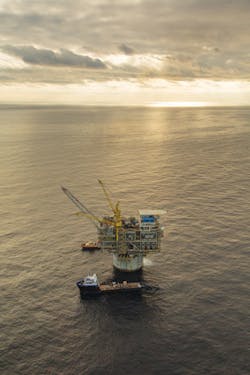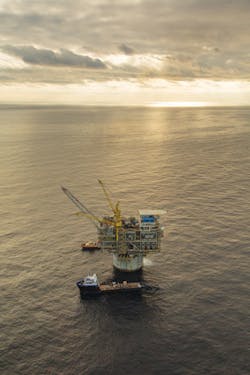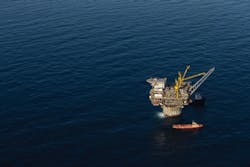Sarah Parker Musarra
Editor
Following the September 2014 decommissioning of its one-of-a-kind cell spar, Red Hawk, in the Gulf of Mexico, Anadarko Petroleum Corp. wasted no time before it made yet another mark in the Gulf. Moored in more than 7,100 ft (2,164 m) of water, the Lucius spar is Anadarko’s biggest and most technically advanced to date, producing from multiple resource-rich fields.
Located about 235 mi (378 km) off Port Fourchon, Louisiana and spanning Keathley Canyon blocks 874, 875, 918 and 919, Lucius was discovered in December 2009. An appraisal well, drilled 3,200 ft (975 m) from the discovery well that encountered 200 ft (61 m) net of oil pay, was completed about 13 months later.
Throughout Lucius’ lifecycle, the Anadarko-led consortium made several decisions that resulted in sizeable savings in both time and money. Also notable are the wild fluctuations in oil prices that have lasted through Lucius’ discovery, to first oil, and even present-day. According to historical data from the US Energy Information Administration, at the time of Lucius’ 2009 discovery, WTI had fallen to an average of $61.95/bbl from $99.67 in 2008 due to the US financial crisis occurring at that time. Prices began to climb between 2009 and 2013 before diving again just before first oil was produced in 2015. In December 2014, WTI fell to $59.29 from a high of $105.79 months earlier, in June. By the time Lucius produced first oil, the industry experienced panic as WTI settled at $47.22.
To manage this price cycle and positively affect project economics, Anadarko signed an agreement in July 2012 with Inpex to enter into a joint-venture capital carry arrangement. Under its terms, Anadarko would be carried for the company’s share of the estimated capital cost until first production: $556 million. This agreement allowed the company to mitigate the risks associated with a long-term megaproject, and limit its exposure to capital burden. Anadarko first successfully carried out the capital-carry model onshore, and the Lucius project marked the first time that the operator applied the concept offshore.
Project development
In January 2010, at the time of appraisal drilling, Anadarko said that the up-dip side track was drilled about 20,600 ft (6,278 m) TD in water depths reaching about 7,100 ft (2,164 m). It encountered almost 600 ft net (183 m) of high-quality oil pay with additional gas-condensate pay in thick subsalt Pliocene and Miocene sands, confirming to the Houston-based company that it now had another major oil and gas discovery in its books. Resources for the development were estimated to be in excess of 300 MMboe.
The project was sanctioned in December 2011. At that time, it was announced that Technip was constructing the Lucius truss spar at its Pori, Finland facility, marking the seventh spar constructed by Technip for Anadarko. The 605 ft (184 m) high spar has a hull weighing 23,000 tons (20,865 metric tons) and a topsides weighing 14,000 tons, with a nameplate capacity of more than 80,000 b/d and 450 MMcf/d (127 MMcm/d) of natural gas. It set sail from Pori for the Gulf of Mexico in April 2013.
Matt Lamey, Anadarko’s facilities project manager for Lucius, said that Technip and Anadarko’s combined experience in the design and construction of spars minimized the challenges normally associated with scaling a design up to Lucius’ proportions.
“We have a really good relationship with Technip,” Lamey said. “Our history with them, and the people that we have here [in Anadarko] that are experienced in building spars made it a very smooth process to build this larger spar.”
The spar’s size also allowed for a larger scope of production.
“The topsides are about 14,000 tons (12,700 metric tons), [whereas] our other topsides were around 10,000 tons (9,071 metric tons),” Lamey explained. “That gives you an idea of the scale up that we have done there. The other thing is, the productive capacity is a bit above the prior spars that we’ve done. The volumes themselves are pretty significant and that required a bit bigger spar.”
In keeping with the speedy development cycle maintained since discovery, Anadarko achieved first oil with Lucius on Jan. 16, 2015, about three years after sanction. Lamey said that the quick cycle from discovery to appraisal was astounding, especially given the size and remoteness of the project.
“It is probably the fastest I’ve ever seen anywhere,” Lamey said. The full cycle time from discovery to our first production was five years. I think for a mega-project, where you’re talking several billion dollars, that’s pretty astounding, when most other projects of this size I see go for probably about twice that length of time.”
Lucius has been operating steadily since first oil.
“The project is going exceptionally well; we are producing right at capacity of the facility,” said Anadarko’s General Manager of the Lucius project Danny Hart. “We have had a run time of about 98% since we brought the project on. We were able to ramp the wells up initially and have been able to sustain right at capacity of the spar since that initial ramp up.”
Production hub
One reason for the steady production are the development’s reservoirs, which Hart characterized as extremely prolific. The Lucius spar pulls from six wells, totaling approximately 80,000 b/d of oil. Hart said that the reservoirs were “some of the highest productivity indexes seen in the Gulf of Mexico.”
The Lucius spar also produces for other neighboring fields. Shortly after sanction, Anadarko finalized a unitization agreement with ExxonMobil. Gas from Hadrian South, located in Keathley Canyon blocks 963 and 964, would be processed through the Lucius spar, which reduced the need for new infrastructure. On March 30, 2015, Hadrian South achieved first production, with daily gross volumes expected to reach around 300 MMcf/d (850 MMcm/d) of gas and 3,000 bbl of liquids from two wells. Hart said that Hadrian South contributes most of the current natural gas production of about 400 MMcf/d. Also in March, Anadarko signed a production-handling agreement with Chevron for its Buckskin/Moccasin discoveries, located in Keathley Canyon blocks 785, 872, and 736, through the Lucius spar as well.
“Obviously, this is a very remote location…We tied up to South Hadrian right off the bat to help to offset some of the costs and to put a hub out there,” Hart said. “We’ve already signed other agreements to tie other fields back through the spar. That hub is providing another income, and the source is allowed to produce significant resources through the spar out in this remote area.”
In another example of how Anadarko worked to save money against the bottom line is evident in Lucius’ infrastructure. A gas line that had served the now-decommissioned Red Hawk cell spar was repurposed into Lucius’ export pipeline. Lamey said that the decision was made prior to sanction while Anadarko was negotiating the oil and gas gathering agreements.
“That is a unique use that we have not seen much in the Gulf of Mexico,” Lamey said, of the decision to re-utilize existing infrastructure by converting the gas line into oil service.
Constructing the long export lines necessary for remote, deepwater projects can greatly impact a project’s budget. Anadarko and the Lucius consortium chose Enterprise to handle the oil export line, and Lamey explained that the economics of the project were greatly improved by re-utilizing the line.
Design choice
Both Lamey and Hart expressed that a spar was a natural design choice when installing in waters as deep as the waters at Lucius (7,000 ft). By design, Lamey said, the spar is more adaptable and therefore needed less bespoke design work.
“It works very well in a variety of metocean conditions,” Lamey said. “It’s got a very low center of gravity and provides very good motion, even in elevated conditions of wind, wave, and current. It provides low impact to the steel risers… It gives you a good design life, with low impact, fatigue, and stress on all those elements that are connected to the spar that make it work.”
A tension leg platform was immediately ruled out, due to the water depth. That left Anadarko and the Lucius consortium with the choice of a spar or a semisubmersible. One issue that factored into the decision was the amount of mooring points needed for that area of the Gulf of Mexico.
“One of the things that made this spar so useful here is that you have a three-point mooring system,” Hart said. “The bathymetry of the ocean floor was very challenging. You have a three-point mooring system as opposed to semis, which would be a four-point mooring system. Finding three mooring points was [already] somewhat of a challenge, so the spar fit really well in this environment.”
Lamey said it was a hallmark of Anadarko’s philosophy that the company would avoid re-inventing the wheel when it was unnecessary, and that is evident in the company’s “design one, build two” philosophy. The truss spar for the Heidelberg development, located in Green Canyon 859 and slated to enter production in 2Q 2016, will be based on the Lucius spar.
Anadarko operates the Lucius spar with a 23.82% interest. Its partners are Freeport-McMoRan (25.123%); ExxonMobil (23.295%); Petrobras (11.500%); Inpex (7.753%); and Eni (8.500%). Eni (12.5%), ExxonMobil (9.375%) and Freeport-McMoran (12.5%) also partner with operator Anadarko (31.5%) on Heidelberg, along with Statoil (12%), Marubeni (12.74%), and Cobalt (9.375%).





